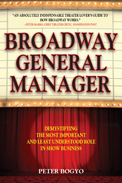
 |
Broadway General Manager: Demystifying The Most Important And Least Understood Role In Show Business
by Peter Bogyo
Allworth Press
A lover of theater since the age of five, Bogyo, a veteran Broadway general manager, is no stranger to show business. Having worked with notable heavyweights such as Cicely Tyson, Stephen Sondheim, Carol Burnett, and Richard Dreyfuss, Bogyo holds an esteemed reputation in the industry. Now he graciously shares his expertise with an honest, inside look into a critical but misunderstood role. His objective here is to answer the question of what precisely a general manager does in an unvarnished book he wishes he had when first starting out. He explores the myriad ways in which a general manager “interacts with people at every level of the production.” Beyond that, Bogyo examines with precise detail the inner workings of theater and production management and the complexities these entail. He literally walks us step-by-step through the day-to-day functions and requirements for developing, organizing, and administrating a major stage production from birth to end.
The author’s intended purpose here is not for this to be a memoir but rather a reference or guide with firsthand knowledge of the behind-the-scenes operations and management of show business. His book becomes instantly invaluable, a gift bestowed with his mastery and comprehension on the subject. It is a book written for the theater student, the aspiring theater manager, the future producer, or even a new producer just beginning. Of course, it is also a book for the theater lover who simply enjoys reading about insider secrets of stage productions.
Bogyo begins by recounting briefly his roots and the surprisingly simple way he got his start in management as a company manager. For Bogyo, company managers are “the hardest working and the most underappreciated [sic] people in theater.” He then informs us of the necessary personality traits and key interests one should possess to be successful as a general manager. He then segues into the nuts and bolts of how large-scale productions are pieced together and run, which fills the bulk of his book. He plainly lays out complex breakdowns of operating budgets and salaries, along with the sometimes staggering numbers of production costs. Just reading this makes one appreciate the work and stress that goes into producing these shows. Above all, he highlights the demands that come with a career in theater management and the importance of a trusting “marriage” between producer and general manager in an industry “built heavily on relationships and reputation.”
Several chapters alone are devoted to specific examples and breakdowns of contracts for various roles in the production, such as actor, director, designer, and of course, general manager. Where necessary, Bogyo infuses cursory overviews of historical context and facts to aid us in understanding present-day productions. While fans see and relish the glamor of stage performances, it is the unseen business behind the curtain that Bogyo brings to light, one that must be coordinated like a well-oiled machine. He also candidly points out that a general manager requires “extensive knowledge” and must “possesses a breadth of experience” to ensure prosperity in this role and give audiences a winning show.
While Bogyo’s narrative is revealing, frank, and altogether informative with excellent tips, it never feels weighty or dry. Nothing is wasted here, and everything is carefully selected to craft this book. One should pay especially close attention to the note sections throughout, where Bogyo gets more personal about his experiences. They are fascinating and worth reading and emerge as the gems of his book. These real-life cases fall into a range of funny, serious, or baffling. One such example is a confusing email correspondence with a producer that was misconstrued by a particular subject line. Another recounts the unfortunate situation of a major star unable to perform due to a bad back. Then he reveals the practical use of certain contraceptives with wireless microphones. These and others demonstrate Bogyo’s capacity and knowledge gained that helped shape his talents, skills, and intuitions to oversee multi-million dollar productions at every turn.
Included throughout is a wealth of information as well as charts, instructions, and terminology. In addition, a glossary is helpfully supplied at the book’s end. With each page, Bogyo’s fondness and upmost respect for the profession become clear. Though the narrative is accessible and digestible, it doesn’t quite have the personal touch one finds in Michael Reidel’s Razzle Dazzle. But Bogyo’s book does share a candidness and depth similar to William Goldman’s The Season coupled with the straightforward practicalities of Michael Shurtleff’s Audition. Bogyo manages to condense years of experience into a reliable, singular book. It is essential reading for anyone to learn and understand the ins and outs of “the life of a show.” Though it will primarily appeal to specific audiences, Bogyo’s empirical and fascinating look at life in the theater can be admired by anyone.
RECOMMENDED by the US Review
Next Focus Review
Previous Focus Review